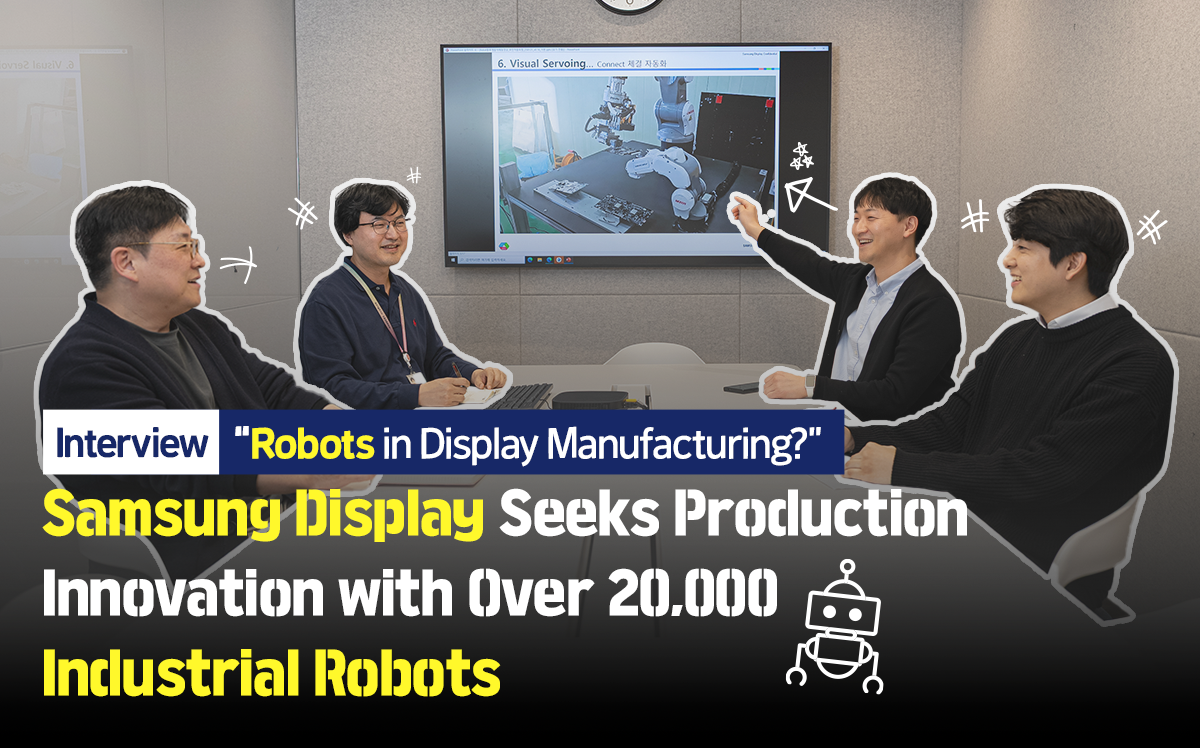
Global big tech companies are diving into the humanoid robot market. Leading the humanoid robot sector, Tesla aims to produce 10,000 Optimus robots by 2025, while FigureAI, invested in by Microsoft, OpenAI, and Nvidia, plans to ship 100,000 humanoid robots over next 4 years. Recently, Meta and Apple have also entered the humanoid competition. Meta has established a new division within its Reality Labs unit to develop AI-powered humanoid robots and is building a basic software platform required for robots. Apple has advanced AI research teams and expects to launch devices that attach a robotic limb to a display.
Domestic companies are also making efforts to preempt the future robot market by forming humanoid alliances. Samsung Electronics has incorporated Rainbow Robotics as a subsidiary and is accelerating its future robot development by deploying quadruped robots for monitoring tasks at Samsung Research America (SRA).
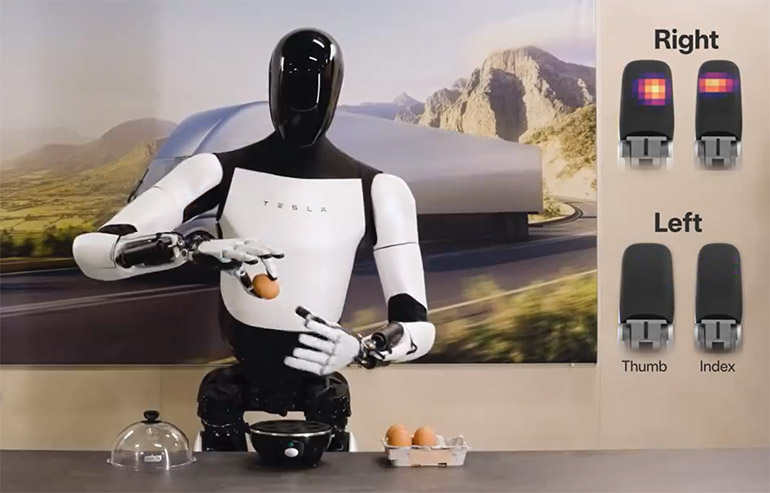
The humanoid robots that global companies are fervently pursuing are a type of service robot capable of substituting human domestic tasks. Robots are broadly categorized into industrial robots and service robots depending on their application.
Samsung Display, a leader in display manufacturing, is devoted to the development of industrial robots by leading innovation in process automation. Samsung Display newsroom met with Jungkook Jang, Donghyuk Yoo, Jihun Kong, and Horim Kim from the Autonomous Factory Team and the Robot Innovation Group, to explore the industrial robots driving automation at Samsung Display's factories.
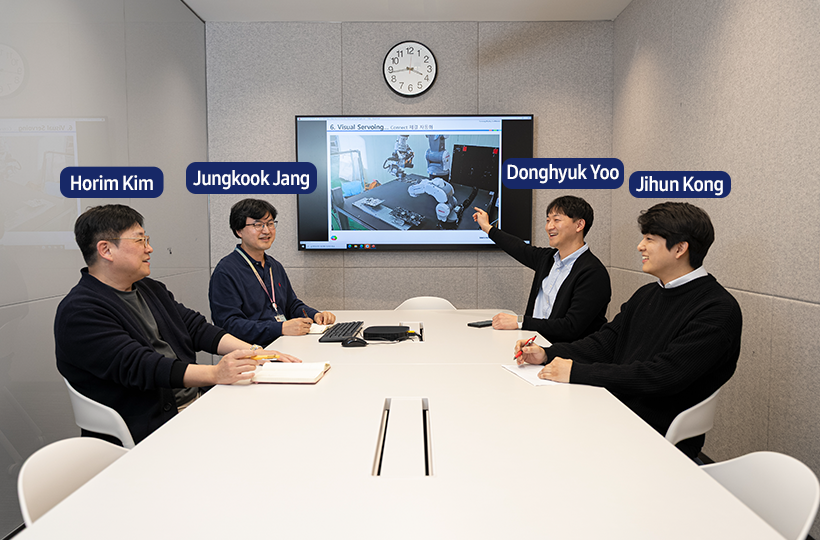
Q. What types of robots are used on the Samsung Display production line?
Jang: Industrial robots at Samsung Display are primarily categorized based on their mobility into stationary and mobile types. Stationary robots include vacuum/transfer robots that transport glass in the FAB process, and small multi-joint robots that handle materials in the module process. Mobile robots include logistics robots that transport products, mobile collaborative robots that perform various tasks, and maintenance robots that monitor the inside of the factory. Other examples include OLEDog, a performance robot specially developed for CES 2025 exhibition to test the durability of OLED by tap dancing and performing aerial back kicks.
Q. What are the benefits of implementing these robots on-site?
Yoo: The mother-glass panels that has finished
First, within the FAB factory, the finished mother-glass panels are transported in containers called cassettes, which weigh up to one ton. This weight would typically necessitate the use of forklifts or other heavy machinery if handled by humans. However, autonomous mobile robots (AMR) can manage loads up to 1.5 tons, ensuring worker safety. Additionally, once these mother-glass panels are cut down to smartphone size, they are placed into plastic containers called trays for transport in module process. To increase the efficiency of this operation, we use automated guided vehicles (AGV) that operate automatically without a driver.
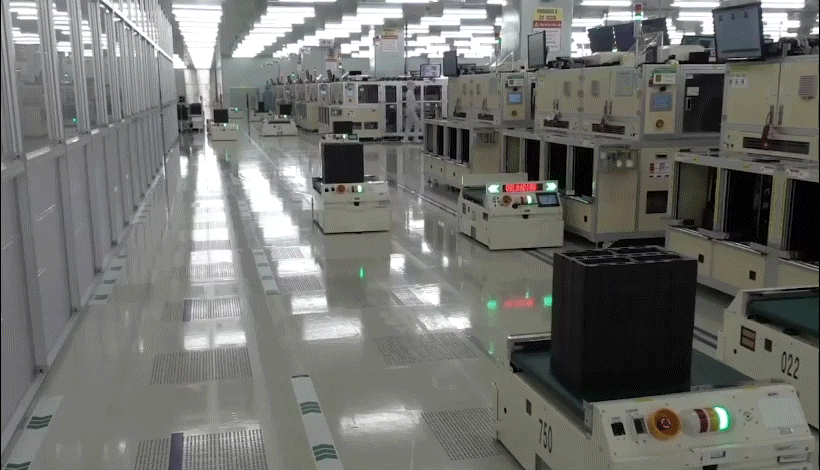
Kong: Additionally, we conduct a drive test by connecting a connector to the product to check if the display is functioning properly in the inspection process. We have developed a visual servoing robot that can accurately locate and connect the connector regardless of the angle at which the display panel is positioned. When connectors were manually connected by operators, the tightness varied significantly depending on the operator's skill level. However, since employing robots, the work tolerance has become extremely precise, up to 50 micrometers, thus significantly improving the precision compared to manual operations.
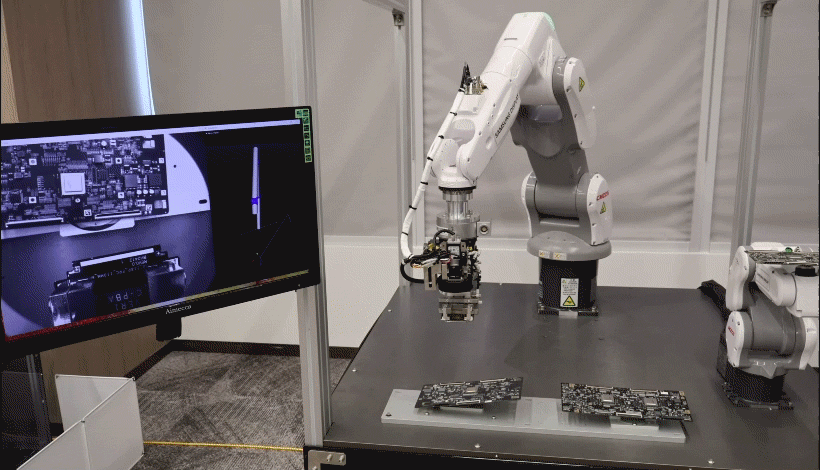
Q. How many robots does Samsung Display have?
Kong: Currently, Samsung Display has deployed approximately 21,000 stationary and mobile industrial robots. Industrial robots were introduced relatively early in the FAB process at Samsung Display, which primarily involves handling mother glass. However, display panel sizes are smaller in the module process so most processes were initially performed manually with frequent use of carts for logistics. Since 2016, when the Mechatronics Technology Research Center began introducing AGV robots at Samsung Display Vietnam (SDV), there has been a significant push in robot development. Now, AMR logistics movements have been standardized across all our global production plants to enhance automated logistics.
According to the World Robotics 2024 report by the International Federation of Robotics (IFR), South Korea's manufacturing sector has the highest robot density in the world, with 1,012 robots per 10,000 employees. At Samsung Display, the robot density is 3,576 robots per 10,000 employees (based on the number of employees in 2023, which is 58,723). This density is high across the country, more than three times the national average.
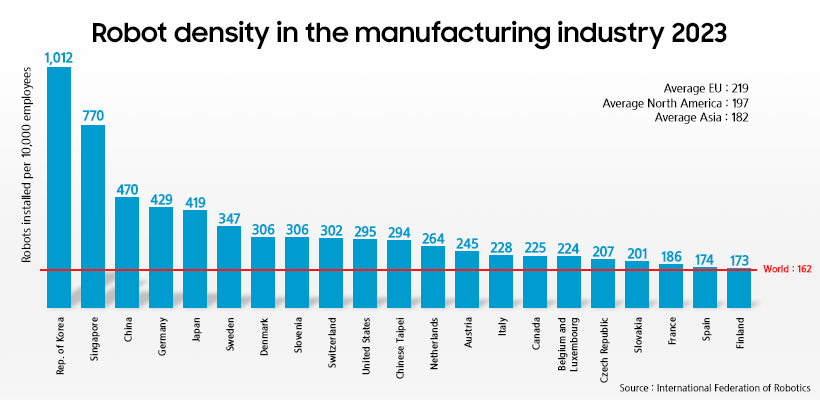
Q. What is the most memorable robot you have worked on in robot development?
Yoo: Since the year before last, a request came from the Strategic Marketing Office of the Small and Medium Business Division to collaborate on robots to be used for an exhibition at MWC24. My experience was primarily in developing robots used on manufacturing lines, so the concept of using robots to promote products was new to me. Consequently, we took a different approach and began searching among the robots at the Mechatronics Technology Research Center, which are intended for research and development purposes. We looked for one that could offer a friendly appearance to visitors, with a form resembling a human.
Yoo: Among them, a dual-arm collaborative robot that was used at SDV in 2019 caught my eye. It had been employed to assist inspection workers by lifting products. Using that robot, I could get an opportunity to participate in developing a program intended for performances to test the durability of display products. The name of this dual-arm robot is 'YuMi'. During the MWC24 exhibition, YuMi's performance captured the attention of attendees and elicited enthusiastic responses and engagement from the audience.
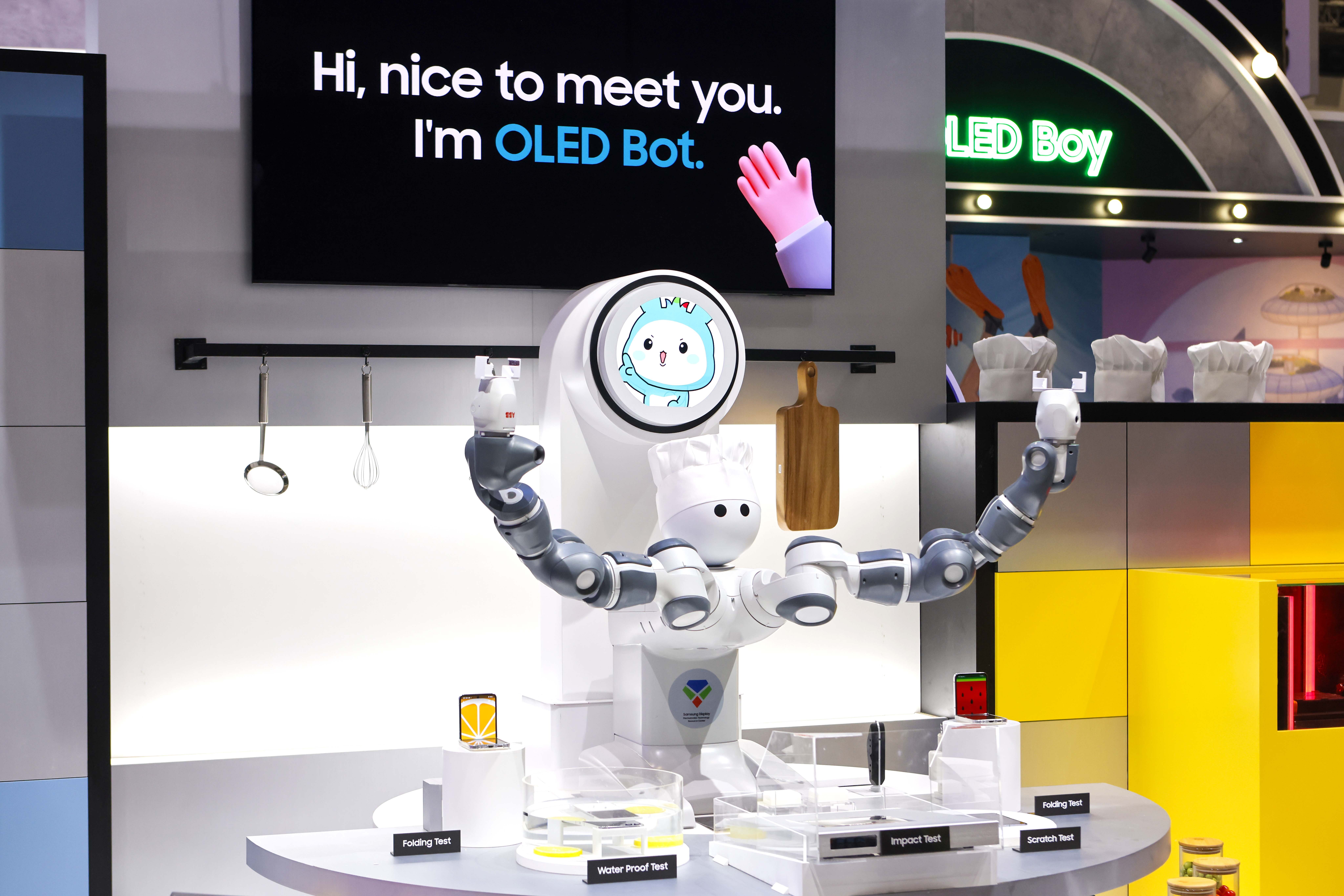
Yoo: Again this year, we came up with the idea of using a friendly, approachable form of a robot dog to show a new performance for the show. This robot dog was originally used at SDV to operate unmanned infrastructure and monitor hazardous areas. However, after being reprogrammed for the CES 2025, it was reborn as OLEDog to test the durability of the panels. It's fascinating to see robots originally developed for manufacturing processes being repurposed and used in different ways, making this one of my most memorable experiences.
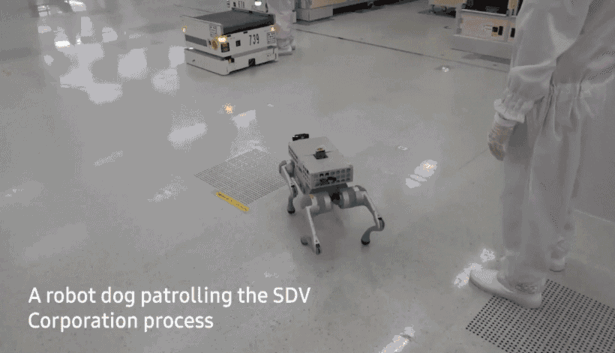
Q. What has been the most rewarding moment in your robot development work?
Kim: We not only develop new types of robots needed for processes but also work to enhance the efficiency of existing robots in our department. At SDV, efficiently managing over 2,000 AGVs has always been our top priority. When AGVs were first introduced to the process, issues frequently arose from overlapping paths, collisions with other AGVs, and path deviation due to the presence of people on the same paths. To prevent this, we introduced traffic light logic at intersections to allow only one AGV to move at a time, and employed Vision AI to recognize objects and control AGVs, thereby advancing AGV management. In addition, we developed algorithms that enable an AGV to detect its surroundings and restart after stopping due to collision or path deviation. This minimizes errors and more than doubles the success rate of automatic AGV transports. This project earned us the year-end comprehensive award within the company. The results obtained from this project are also planned to be applied to future intelligent robot systems.
Q: What types of robots will Samsung Display need in the future?
Jang: Until now, the robots we have developed have primarily performed simple, repetitive tasks. In the future, we plan to develop intelligent robots capable of performing non-standard tasks, such as autonomously repairing or conducting maintenance and inspections when equipment unexpectedly breaks down during operation. To achieve this, we need to develop not only existing robotic technologies but also physical AI technologies that robots will possess intelligence and interact with external environments by implementing and applying AI technologies in real physical environments. Internally, we are enhancing the robots’ operational intelligence by using vision cameras to recognize the surrounding work environment and employing large language models. We are also training robots to perform motions specific to our worksites, aiming to develop optimal robots suited for our company. Furthermore, we plan to expand the types of robots from stationary ones to humanoid robots that can walk on two legs and resemble human physiology, making them applicable to our fields.
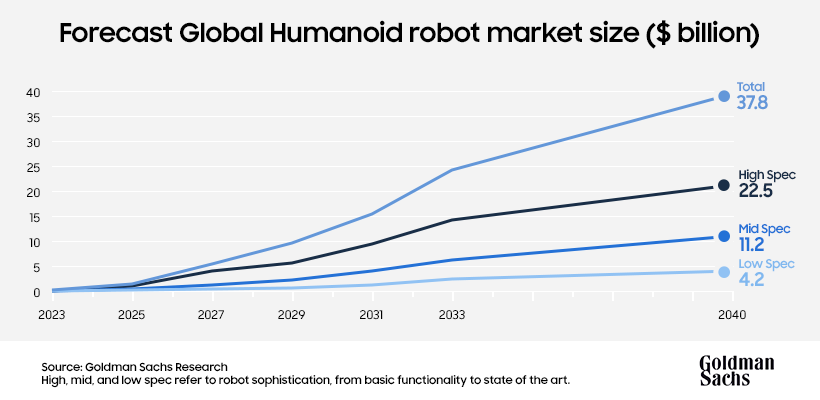
According to the World Robotics 2024 report published by the International Federation of Robotics, as of 2023, approximately 4,281,585 industrial robots are in operation worldwide. Furthermore, Goldman Sachs predicts that the global humanoid robot market will grow to about $38 billion by 2035.
Just as AI has transformed industries over the past two years, interest in and investment in robotic technology are expected to expand significantly in the coming years. Industrial automation is becoming a key competitive factor in manufacturing, and in the display industry, process innovation using robots is becoming essential. Let’s look forward to Samsung Display’s continued development of industrial robots necessary for manufacturing processes—not only advancing display technology but also leading manufacturing innovation.

